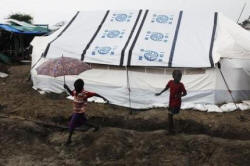|
 Aid,
rain save South Sudan from famine, 2015 outlook grim:
WFP Aid,
rain save South Sudan from famine, 2015 outlook grim:
WFP
 Send a link to a friend
Send a link to a friend
[September 25, 2014] By
Katy Migiro
NAIROBI (Thomson Reuters
Foundation) - Emergency food aid, normal rainfall and
the start of the harvest have helped to stave off famine
in South Sudan, the latest analysis shows, but there is
a risk of mass starvation in early 2015. |
|
 Aid agencies scrambled to avert famine in South Sudan by launching
the world’s largest humanitarian operation after fighting erupted in
the world's youngest country in December. Aid agencies scrambled to avert famine in South Sudan by launching
the world’s largest humanitarian operation after fighting erupted in
the world's youngest country in December.
Some 10,000 people have died and 1.7 million, one seventh of the
population, have been displaced since conflict broke out between
President Salva Kiir's government forces and rebels allied to his
former deputy Riek Machar.
“There is no famine in South Sudan,” the agriculture, fisheries,
cooperatives and rural development ministry said in a statement.
"Food security across the country has begun improving and is
expected to continue on a positive trend through December.”
But the World Food Programme, looking ahead, said “The outlook
remains grim for early 2015, especially in conflict affected
states.”
“Food security may deteriorate sharply early next year as their food
stocks run out,” it said in a statement.

The number of people in crisis and emergency, phases three and four
on a five-point scale where five is famine, has fallen to 1.5
million from 3.9 million, experts said on Tuesday.
The Integrated Food Security Phase Classification (IPC) assessment
was carried out by hunger experts from aid agencies and the
government.
A famine is declared when at least 20 percent of households in an
area face extreme food shortages with a limited ability to cope;
acute malnutrition rates exceed 30 percent; and the death rate
exceeds two people per 10,000 per day.
In Somalia’s 2011 famine, the majority of the 260,000 people who
died lost their lives before famine was officially declared.
[to top of second column] |

Aid agencies called for continued funding for the crisis in South
Sudan, which has received almost $1.2 billion from donors this year.
“When we get distracted by language and trying to define a problem
in abstract percentages we can forget that every night more people
than the population of the city of Los Angeles go to sleep hungry,”
WorldVision’s South Sudan Program Director Perry Mansfield said in a
statement.
Malnutrition rates remain above the emergency threshold of 15
percent in most of the country, the IPC said.
The number of people in IPC phases three and four is predicted to
rise to 2.5 million in January. Experts will have a clearer picture
of the situation when the October harvest is in.
(Reporting by Katy Migiro, editing by Tim Pearce)
[© 2014 Thomson Reuters. All rights
reserved.] Copyright
2014 Reuters. All rights reserved. This material may not be
published, broadcast, rewritten or redistributed.

 |